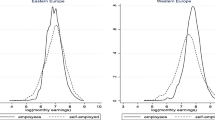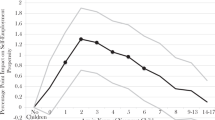Abstract
Low-skilled workers do not fare well in today’s skill intensive economy and their opportunities continue to diminish. Utilizing data from the survey of income and program participation, this paper provides an analysis of the economic returns to business ownership among low-skilled workers and addresses the essential question of whether self-employment is a good option for low-skilled individuals that policymakers might consider encouraging. The analysis reveals substantial differences in the role of self-employment among low-skilled workers across gender and nativity—women and immigrants are shown to be of particular importance from both the perspectives of trends and policy relevance. We find that, although the returns to low-skilled self-employment among men is higher than among women, the analysis shows that wage/salary employment is a more financially rewarding option for most low-skilled workers.
Similar content being viewed by others
Notes
We use the terms self-employed, entrepreneur and business owner synonymously in this paper.
This suggests that the decline in the number of low-skilled U.S.-born business owners is due to the overall increase in educational attainment and possibly to a decrease in low-skilled labor force participation among native-born.
Some existing research also suggests that the returns to self-employment may vary across ethnic groups; see, for example, Aguilera (2009).
Although estimates are not presented in this paper, the pattern of higher returns to education among business owners is also found in the data utilized in this paper, the survey of income and program participation (SIPP).
Although the 2004 Panel was originally set to have 12 waves with a full set of topical modules, due to budget constraints, the topical modules were not collected for waves 9–12. Furthermore, the sample was cut by half for this time period.
A look at the overall mean log of total annual earnings differences shows that the total annual earnings of business owners is about 10% lower than the earnings of wage/salary workers. The log transformation of total annual earnings reduces the influence of the highest-earning individuals. Hence, the difference in mean log annual earnings is closely in line with a comparison of median annual earnings.
Specifications with lagged labor force status (i.e., whether the person was observed in wage/salary work, part-time self-employment, unemployed, welfare participation or not in the labor force in the previous year) were also estimated. When lagged labor market status controls are added to the specification described in the model above, the point estimates indicate somewhat smaller earnings differences between low-skilled wage/salary workers and entrepreneurs. Importantly, the conclusions discussed below do not hinge on the incorporation of these variables.
The estimates in columns (1) and (3) do not exactly reflect the unadjusted differences since year effects are included in the specifications.
We use eb-1, where b is the estimated coefficient, to convert the log point estimates into percentages.
The coefficients and t stats in the self-employment columns of Table 4 provide estimates to test for differential impacts of the variable in question between wage/salary workers and the self-employed as well as for differences in the returns to low-skilled self-employment. For example, the results for men show that Hispanic wage/salary workers have about 13% lower annual earnings than otherwise observationally identical non-Hispanic white male employees. Furthermore, the −0.031 point estimate in the self-employment column is statistically insignificant, indicating that there is no difference in the low-skilled Hispanic-white earnings gap between employees and entrepreneurs. Hence the estimated self-employment disadvantage of about 32% holds for both non-Hispanic whites and Hispanics.
We also utilized Oaxaca earnings decompositions to more specifically analyze how observable earnings related factors affect the earnings differences between wage/salary workers and the self-employed. To do so, we estimated separate regression models by gender and nativity. This exercise also shows that for all groups the self-employment earnings disadvantages are greater once observable factors are considered (results are not shown here but are presented in Lofstrom 2009).
Given the possibility that the experience and age coefficients are only weakly identified in a fixed effects model with year dummies, we present the estimated models with no year fixed effects. However, we note that the estimates with year fixed effects, not shown, generate patterns almost identical to those presented in Table 7. Hence, the conclusions in this paper remain the same whether year fixed effects are incorporated or not.
In a sample of college graduates, the estimated earnings gaps are somewhat smaller, and even positive (but insignificant) among female immigrant college graduates, but overall not substantially different from those among low-skilled workers (results are shown in Table 8).
The results are not included but are available upon request from the author.
The number of low-skilled female native entrepreneurs increased but this was offset by a greater decline among low-skilled native men.
There may well be non-monetary rewards that attract individuals to self-employment, including greater work autonomy and control, and these may be sufficiently appealing to counterbalance self-employment’s earnings disadvantage.
References
Aguilera, M. B. (2009). Ethnic enclaves and the incomes of self-employed Latinos. Small Business Economics, 33(4), 413–426.
Borjas, G. J. (1986). The self-employment experience of immigrants. Journal of Human Resources, 21, 485–506.
Brock, W. A. & Evans, D. S. (1986). The Economics of Small Business. New York: Holmes & Meier.
Cummings, S. (Ed.). (1980). Self-help in urban America: Patterns of minority business enterprise. Kenikart Press: New York.
Evans, D. S., & Leighton, L. S. (1989). Some empirical aspects of entrepreneurship. American Economic Review, 79, 519–535.
Fairlie, R. W. (2004). Earnings growth among less-educated business owners. Industrial Relations, 43(3), 634–659.
Fairlie, R. W. (2005). Entrepreneurship and earnings among young adults from disadvantaged families. Small Business Economics, 25(3), 223–236.
Fairlie, R. W. (2006). Entrepreneurship among disadvantaged groups: An analysis of the dynamics of self-employment by gender, race and education, Vol. 2. In S. C. Parker, Z. J. Acs, & D. R. Audretsch (Eds.), Handbook of entrepreneurship. Dordrecht: Kluwer Academic Publishers.
Fairlie, R. W., & Meyer, B. D. (1996). Ethnic and racial self-employment differences and possible explanations. Journal of Human Resources, 31, 757–793.
Glazer, M., & Moynihan, D. P. (1970). Beyond the melting pot: the Negroes, Puerto ricans, Jews, Italians and Irish of New York City. Cambridge: MIT Press.
Hamilton, Barton. H. (2000). Does entrepreneurship pay? An empirical analysis of the returns of self-employment. The Journal of Political Economy, 108(3), 604–631.
Hartog, J., van Praag, M., & van der Sluis, J. (2010). If you are so smart, why aren’t you an entrepreneur? Returns to cognitive and social ability: Entrepreneurs versus employees. Journal of Economics and Management Strategy, 19(4), 947–989.
Holtz-Eakin D., Rosen, H. S., & Weathers, R. (2000). Foratio Alger meets the mobility tables. Small Business Economics, 14(4), 243–274.
Lofstrom, M. (2002). Labor market assimilation and the self-employment decision of immigrant entrepreneurs. Journal of Population Economics, 15(1), 83–114.
Lofstrom, M. (2009). Does self-employment increase the economic well-being of low-skilled workers?. IZA Discussion Paper No. 4539, October.
Lofstrom, M. (2010). Entrepreneurship among California’s low-skilled workers, PPIC Report, April.
Parker, S. C. (2009). The economics of entrepreneurship. Cambridge: Cambridge University Press.
Parker, S., & van Praag, M. (2006). Schooling, capital constraints and entrepreneurial performance: The endogenous triangle. Journal of Business and Economic Statistic, 24(4), 416–431.
Rees, H., & Shah, A. (1986). An empirical analysis of self-employment in the U.K. Journal of Applied Econometrics, 1(1), 95–108
Van der Sluis, J., Van Praag, C. M., Vijverberg, W. (2008). Education and entrepreneurship selection and performance: A review of the empirical literature. Journal of Economic Surveys, 22(5), 795–841.
Van Praag, M., van Witteloostuijn, A. & Van der Sluis, J. (2009). Returns for entrepreneurs versus employees: The effect of education and personal control on the relative performance of entrepreneurs vis-à-vis wage employees. Tinbergen Institute Discussion Paper TI 2009-111/3. Amsterdam: University of Amsterdam.
Yuengert, A. M. (1995). Testing hypotheses of immigrant self-employment. Journal of Human Resources, 30, 194–204.
Zissimopoulos, J. M., & Karoly, L. A. (2007). Transitions to Self-employment at older ages: The role of wealth, health, health insurance and other factors. Labour Economics, 14, 269–295.
Author information
Authors and Affiliations
Corresponding author
Rights and permissions
About this article
Cite this article
Lofstrom, M. Does self-employment increase the economic well-being of low-skilled workers?. Small Bus Econ 40, 933–952 (2013). https://doi.org/10.1007/s11187-011-9402-z
Accepted:
Published:
Issue Date:
DOI: https://doi.org/10.1007/s11187-011-9402-z




